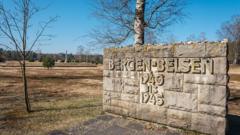Eighty years have passed since the liberation of Bergen-Belsen, a concentration camp in northern Germany that became a symbol of the horrendous human suffering caused by the Holocaust. On April 15, 1945, British and Canadian troops discovered a scene so horrific that it reshaped perceptions of Nazi atrocities. Reports had emerged about the camp's conditions, but nothing prepared the liberators for the sheer scale of death: an estimated 13,000 unburied bodies and 60,000 emaciated survivors.
To mark this significant anniversary, over a thousand survivors and their families gathered at the camp for memorial ceremonies, reflecting on the trauma endured. British soldier Michael Bentine, who later became an entertainer, poignantly described Belsen as "the ultimate blasphemy." The first broadcaster to enter the camp, Richard Dimbleby, captured its horrors in 1945, lamenting that it was “the most horrible of my life.”
Bergen-Belsen became notorious not just for its grim reality but for the chilling accounts documented by journalists and soldiers. Unlike other camps, such as Treblinka and Auschwitz, which were destroyed to erase evidence, Belsen retained its horrors. Witnesses—including both survivors and perpetrators—painted a vivid picture of the suffering that ensued from overcrowding, malnutrition, and the prevalence of disease.
Many notable figures were among the victims in the final weeks of the war, including Anne Frank and her sister Margot. As liberation approached, approximately 50,000 to 70,000 people had perished at the camp, often succumbing to circumstances exacerbated by the end of the war. In the aftermath, nearly 14,000 more died after liberation, as their bodies struggled to recover from severe malnutrition.
On Sunday, dignitaries such as Deputy Prime Minister Angela Rayner and UK Chief Rabbi Sir Ephraim Mirvis took part in the ceremonies. Survivors, including 180 British Jews organized by Ajex, the Jewish Military Association, laid wreaths in a tribute to those lost. Today’s visitors stand amidst a landscape marked not by the camp's former horrors, but by a visitor center and memorial stones, with inscriptions like "Hier ruhen 5,000 toten" or "here rest 5,000 dead," a stark reminder of the lives claimed by this dark chapter in history.





















